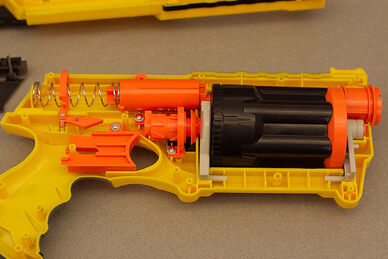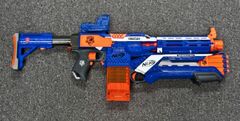
An opened Maverick about to be modified.
Blaster modification is a common practice of Nerfers in which they modify their Nerf blasters in a variety of ways. Modding almost always requires a modder to manually open up their blaster and remove or change its internals. Modding is very popular among Nerf enthusiasts, so much so that buying a new blaster is seen somewhat as a blank canvas. At the time of purchase, the person is more interested in buying something to improve than buying something to use.
Hasbro does not support the modification of blasters. However, they may not want to put an end to it, as it is one of the strongest points in the Nerfing community and economy.
Blasters that are not modified are considered "stock blasters".
Common modifications[]
Air restrictor removal[]
The simplest and most basic modification, modders remove components from the blaster called air restrictors in order to increase a blaster's range and accuracy. Removing it also allows the blaster to fire darts that are not meant for it. The air restrictors are typically found inside of the barrels where darts are launched. It is quite possibly the most common form of modding. Air restrictors restrict the amount of air-flow that reaches the dart. They also help cushion the plunger, so it is less-likely to break.
There is a risk to removing air restrictors, such as shortening lifespan, too much force inflicted and accidentally removing intelligent air restrictors. These types of air restrictors are pushed back to unlock air flow. If removed, it will either permanently lock the air flow, or fire all darts as once (If it is a multi shot blaster such as the Rough Cut 2x4 or the Triad EX-3).
Barrel replacements[]
Some modders replace the barrels in their blaster. When adding a new barrel, the darts will have a greater accuracy and range due to the new barrel's tighter air seal, which prevents air leaks and focuses the power into the dart or ammunition. Modders usually use brass, CVPC, or PETG tubes as replacement barrels.
Spring spacers[]
Spring spacers consist of objects like coins, and small pieces of cardboard, sections of PVC pipe are placed behind a spring to apply more compression to the spring. Doing this will increase the preload to the spring and allow for a more efficient use of the spring's potential power, usually increasing the power of a blaster. This is the easiest to do on a reverse plunger.
Spring replacement[]
Spring replacement is simple and is when the modder replaces the spring on their blaster. The spring can improve power greatly. Though if putting in a stronger spring, the modder should increase the catch spring, pad the plunger, and use modded darts. These will make the plunger less likely to snap from increase in power.
Spring stretching[]
Stretching a spring is also simple. The spring is removed from the blaster and is stretched out by hand a bit. However, this mod only lasts for a few shots and generally reduces the lifespan of the spring. A spring replacement is suggested for long term use. Certain blasters after this modification will require more effort to prime the new spring.
Coupler mod[]
Common for single fire blasters (i.e. Nite Finder EX-3, Scout IX-3, etc.), this involved putting a piece of PVC into the barrel and attaching a coupler. This allows use with other darts and speedloaders.
Integration[]
Integration involves integrating two or more blasters to a single object. Integrations are popular among the modding community. These are usually done by chopping a blaster down, and attaching it to another blaster via epoxy putty, hot glue, bolting together or other methods.
Masterkey integration[]

A Stryfe with a Rough Cut masterkey.
A masterkey integration is when someone connects a smaller blaster into a bigger blaster (for example: a Rough Cut integrated to a Retaliator). It takes its name from the real-life KAC Masterkey shotgun system, which consists of a pump-action shotgun mounted to the underbarrel of a firearm. The blasters which are most used as masterkeys are the Rough Cut 2x4, the Strongarm, and the Magnus, the latter two mounted upside down.
The Stryfe is a very popular base for integration mods.
Overvolting[]
Overvolting is a term used to describe an intentional increase in the stock voltage of a blaster to boost performance. This is usually accomplished through the usage of of extra alkaline batteries in new cell holders, using 9V batteries (not recommended due to short lifespan), or lithium cells such as 14500 sized TrustFires or IMRs. Often this is done with little modification to the stock wiring apart from bypassing electrical components such as thermistors. This can have different effects whether it be increasing the rate of fire in electrical spring blasters or fully-automatic flywheel blasters, or increasing the power of flywheel blasters. Compared to recent techniques such as replacing wiring and utilizing better power sources such as battery packs, overvolting is less reliable, less safe, and yields less performance.
Rewire[]
A rewire is a term used to describe the act of replacing all the wires in an electrical blaster such as a flywheel blaster or electrical spring blaster. Usually the new circuit is simplified, lower resistance, and bypasses all previous locks. Common additions to a rewiring a blaster are motor upgrades to increase performance (and often reliability), microswitch upgrades to increase reliability, and the addition of voltage meters to keep a reading on the battery life left. A rewired blaster will often operate at a higher voltage than stock blasters, but this is usually because optimal performance with common motor selections requires higher voltage than stock, some motors may be preferably run at lower voltages than stock.
| view • editModification | |
|---|---|
| Blaster modification | 3D printing • Homemade blaster (+Bow • Rainbow blaster • SNAP) • Painting • Voltage modification |
| Dart modification | Dart head • Grenade • Speedloader • Stefan |
